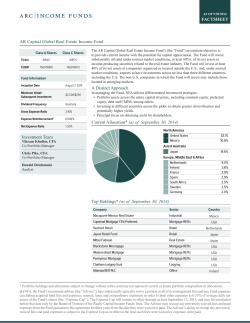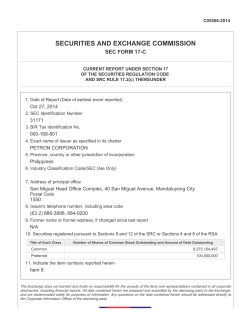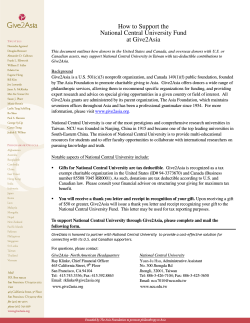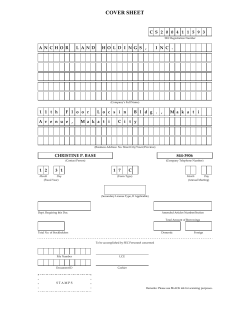
Deutsche European Equity Fund
SUPPLEMENT TO THE CURRENTLY EFFECTIVE PROSPECTUS AND SUMMARY PROSPECTUS OF THE LISTED FUND Deutsche European Equity Fund The fund has not yet commenced operations. The fund expects to commence operations on or about November 11, 2014. The fund will not be publicly available for purchase until on or about December 1, 2014. Please Retain This Supplement for Future Reference November 7, 2014 PROSTKR‐456 Summary Prospectus | November 3, 2014 Deutsche European Equity Fund Class/Ticker A DURAX C DURCX INST DURIX S DURSX Before you invest, you may want to review the fund’s prospectus, which contains more information about the fund and its risks.You can find the fund’s prospectus, Statement of Additional Information (SAI) and other information about the fund online at deutschefunds.com/ mutualpros.You can also get this information at no cost by e-mailing a request to service@db.com, calling (800) 728-3337 or asking your financial advisor.The prospectus and SAI, both dated November 3, 2014, as supplemented, are incorporated by reference into this Summary Prospectus. INVESTM ENT OB J E CT IV E The fund seeks long-term growth of capital. The Advisor has contractually agreed through November 2, 2015 to maintain the fund’s total annual operating expenses (excluding extraordinary expenses, taxes, brokerage and interest expense) at 1.55%, 2.30%, 1.30% and 1.40% for Class A, Class C, Institutional Class and Class S, respectively. The agreement may only be terminated with the consent of the fund’s Board. F EES AND EXPEN S E S O F T H E F UN D These are the fees and expenses you may pay when you buy and hold shares. You may qualify for sales charge discounts if you and your immediate family invest, or agree to invest in the future, at least $50,000 in Deutsche funds. More information about these and other discounts is available from your financial professional and in Choosing a Share Class in the prospectus (p. 11) and Purchase and Redemption of Shares in the fund’s SAI (p. II-15). EXAMPLE This Example is intended to help you compare the cost of investing in the fund with the cost of investing in other mutual funds. The Example assumes that you invest $10,000 in the fund for the time periods indicated and then redeem all of your shares at the end of those periods. The Example also assumes that your investment has a 5% return each year and that the fund’s operating expenses (including one year of capped expenses in each period for Class A, Class C and Class S) remain the same. Although your actual costs may be higher or lower, based on these assumptions your costs would be: SHAREHOLDER F E E S (paid directly from your investment) A Maximum sales charge (load) imposed on purchases, as % of offering price Maximum deferred sales charge (load), as % of redemption proceeds Redemption/exchange fee on shares owned less than 15 days, as % of redemption proceeds Account Maintenance Fee (annually, for fund account balances below $10,000 and subject to certain exceptions) C INST S 5.75 None None None None 1.00 None None Years 2.00 $20 2.00 2.00 $20 None A C INST S 1 $ 724 $333 $132 $143 3 1,070 747 412 464 2.00 $20 You would pay the following expenses if you did not redeem your shares: ANNUAL FUND O P E RAT IN G E X P E N S E S Years (expenses that you pay each year as a % of the value of your investment) A C INST 0.80 A C INST S 1 $ 724 $233 $132 $143 3 1,070 747 412 464 S Management fee 0.80 0.80 0.80 Distribution/service (12b-1) fees 0.25 1.00 None None Other expenses1 0.67 0.64 0.50 0.70 Total annual fund operating expenses 1.72 2.44 1.30 1.50 Fee waiver/expense reimbursement 0.17 0.14 0.00 0.10 Total annual fund operating expenses after fee waiver/expense reimbursement 1.55 2.30 1.30 1.40 PO RTFO LIO TURNOVER The fund pays transaction costs, such as commissions, when it buys and sells securities (or “turns over” its portfolio). A higher portfolio turnover may indicate higher transaction costs and may mean higher taxes if you are investing in a taxable account. These costs are not reflected in annual fund operating expenses or in the expense example, and affect the fund’s performance. 1 “Other expenses” are based on estimated amounts for the current fiscal year. 1 Since the fund has been operational for less than one year, portfolio turnover information is not available. As part of the management process, members of the portfolio management team frequently meet with company management and/or visit companies being considered by the portfolio management team. Portfolio management believes that company meetings create an important source of information to help portfolio management develop an understanding of a company’s strategy and ability to deliver shareholder value. Portfolio management is supported by a large and experienced team of investment analysts. In identifying potential investments, portfolio management will assess the general outlook for European equities. The key drivers of this outlook are growth, valuation and sentiment. This process is then applied at individual country and sector levels to determine country and sector weightings. PRINC IPAL INVEST M E NT ST R AT E GY Main investments. Under normal circumstances, the fund invests at least 80% of its net assets, plus the amount of any borrowings for investment purposes, in equity securities and other securities with equity characteristics of issuers domiciled in Europe. In addition to common stock, other securities with equity characteristics such as preferred stock, convertible securities and warrants are counted toward satisfaction of this 80% investment policy. An issuer is deemed to be “domiciled” in Europe if: (1) it is organized under the laws of a European country, or maintains its headquarters or a principal place of business in Europe; (2) it derives 50% or more of its revenues and profits from goods produced or sold, investments made, or services performed in Europe or has 50% or more of its assets in Europe; or (3) its equity securities are traded principally in Europe. Derivatives. In addition to participation notes, portfolio management generally may use futures contracts, which are a type of derivative (a contract whose value is based on, for example, indices, currencies or securities) as a substitute for direct investment in a particular asset class or to keep cash on hand to meet shareholder redemptions. Portfolio management may also generally use forward currency contracts to hedge the fund’s exposure to changes in foreign currency exchange rates on its foreign currency denominated portfolio holdings or to facilitate transactions in foreign currency denominated securities. Company-specific criteria drive security selection and the portfolio management team seeks to identify securities of companies that the portfolio management team believes have a good market position, forward-looking products, expert management, a corporate strategy that concentrates on core competencies, yield-oriented use of resources and sustainable, above-average growth in profitability. The fund may invest in any country, including emerging markets, or sector. Portfolio management intends to focus on companies with a larger market capitalization though companies of all capitalizations are considered for investment. The fund expects to maintain a portfolio of 50-70 stocks. Lastly, the fund may also use various types of derivatives, including stock options and total return swaps (i) for hedging purposes; (ii) for risk management; (iii) for non-hedging purposes to seek to enhance potential gains; or (iv) as a substitute for direct investment in a particular asset class or to keep cash on hand to meet shareholder redemptions. The fund normally invests primarily in common stocks, but may also invest in preferred stocks, convertible securities, debt securities, short-term securities, participation notes, structured notes, futures contracts, stock options, total return swaps, warrants and other securities. The fund may invest up to 20% of its assets in short-term securities and cash equivalents. Securities Lending. The fund may lend securities (up to one-third of total assets) to approved institutions. MAIN RISKS There are several risk factors that could hurt the fund’s performance, cause you to lose money or cause the fund’s performance to trail that of other investments. The fund may not achieve its investment objective, and is not intended to be a complete investment program. An investment in the fund is not a deposit of a bank and is not insured or guaranteed by the Federal Deposit Insurance Corporation or any other governmental agency. Management Process. Portfolio management uses an active bottom-up investment philosophy by seeking to identify companies that portfolio management believes have above-average earnings potential relative to the market or their respective peer group as well as companies whose earnings appear mispriced by the market. Portfolio management intends to focus on companies that it believes have one or more of the following characteristics, among others: 䡲 Good market position; 䡲 Quality management; 䡲 Strong balance sheet; and 䡲 Shareholder-focused orientation characterized by alignment of management’s compensation and incentive packages with shareholder interests as well as regular communication with investors. Stock market risk. When stock prices fall, you should expect the value of your investment to fall as well. Stock prices can be hurt by poor management on the part of the stock’s issuer, shrinking product demand and other business risks. These may affect single companies as well as groups of companies. In addition, movements in financial markets may adversely affect a stock’s price, regardless of how well the company performs. To the extent that the fund invests in a particular geographic region or market sector, performance will be affected by that region’s or sector’s general performance. 2 Deutsche European Equity Fund Summary Prospectus November 3, 2014 Regional focus risk. Focusing investments in a single country or few countries, or regions, involves increased currency, political, regulatory and other risks. Market swings in such a targeted country, countries or regions are likely to have a greater effect on fund performance than they would in a more geographically diversified fund. Also, there may be delays in recovery of securities loaned or even a loss of rights in the collateral should the borrower of the securities fail financially while holding the security. Counterparty risk. A financial institution or other counterparty with whom the fund does business, or that underwrites, distributes or guarantees any investments or contracts that the fund owns or is otherwise exposed to, may decline in financial health and become unable to honor its commitments. This could cause losses for the fund or could delay the return or delivery of collateral or other assets to the fund. Foreign investment risk. The fund faces the risks inherent in foreign investing. Adverse political, economic or social developments could undermine the value of the fund’s investments or prevent the fund from realizing the full value of its investments. Financial reporting standards for companies based in foreign markets differ from those in the US. Additionally, foreign securities markets generally are smaller and less liquid than US markets. To the extent that the fund invests in non-US dollar denominated foreign securities, changes in currency exchange rates may affect the US dollar value of foreign securities or the income or gain received on these securities. Credit risk. The fund’s performance could be hurt if an issuer of a security suffers an adverse change in financial condition that results in the issuer not making timely payments of interest or principal, a security downgrade or inability to meet a financial obligation. Growth investing risk. As a category, growth stocks may underperform value stocks (and the stock market as a whole) over any period of time. Because the prices of growth stocks are based largely on the expectation of future earnings, growth stock prices can decline rapidly and significantly in reaction to negative news about such factors as earnings, the economy, political developments, or other news. Emerging markets risk. Foreign investment risks are greater in emerging markets than in developed markets. Investments in emerging markets are often considered speculative. Security selection risk. The securities in the fund’s portfolio may decline in value. Portfolio management could be wrong in its analysis of industries, companies, economic trends, the relative attractiveness of different securities or other matters. Mid- and small-cap risk. Investments in mid-capitalization and small-capitalization companies involve greater risks than those associated with larger, more established companies. These securities may be subject to more abrupt or erratic price movements and may lack sufficient market liquidity, and these issuers often face greater business risks. Liquidity risk. In certain situations, it may be difficult or impossible to sell an investment in an orderly fashion at an acceptable price. Pricing risk. If market conditions make it difficult to value some investments, the fund may value these investments using more subjective methods, such as fair value pricing. In such cases, the value determined for an investment could be different than the value realized upon such investment’s sale. As a result, you could pay more than the market value when buying fund shares or receive less than the market value when selling fund shares. Interest rate risk. When interest rates rise, prices of debt securities generally decline. The longer the duration of the fund’s debt securities, the more sensitive it will be to interest rate changes. (As a general rule, a 1% rise in interest rates means a 1% fall in value for every year of duration.) Derivatives risk. Risks associated with derivatives include the risk that the derivative is not well correlated with the security, index or currency to which it relates; the risk that derivatives may result in losses or missed opportunities; the risk that the fund will be unable to sell the derivative because of an illiquid secondary market; the risk that a counterparty is unwilling or unable to meet its obligation; and the risk that the derivative transaction could expose the fund to the effects of leverage, which could increase the fund’s exposure to the market and magnify potential losses. Prepayment and extension risk. When interest rates fall, issuers of high interest debt obligations may pay off the debts earlier than expected (prepayment risk), and the fund may have to reinvest the proceeds at lower yields. When interest rates rise, issuers of lower interest debt obligations may pay off the debts later than expected (extension risk), thus keeping the fund’s assets tied up in lower interest debt obligations. Ultimately, any unexpected behavior in interest rates could increase the volatility of the fund’s share price and yield and could hurt fund performance. Prepayments could also create capital gains tax liability in some instances. Securities lending risk. Any decline in the value of a portfolio security that occurs while the security is out on loan is borne by the fund and will adversely affect performance. PAST PERFO RMAN CE Since the fund is newly offered, performance information is not available. 3 Deutsche European Equity Fund Summary Prospectus November 3, 2014 Institutional Class shares are generally available only to qualified institutions. Class S shares are only available to a limited group of investors. MANAGEMENT Investment Advisor Deutsche Investment Management Americas Inc. Portfolio Manager(s) Britta Weidenbach, CFA, Managing Director. Lead Portfolio Manager of the fund. Began managing the fund in 2014. TAX IN FO RMATIO N The fund’s distributions are generally taxable to you as ordinary income or capital gains, except when your investment is in an IRA, 401(k), or other tax-deferred investment plan. Any withdrawals you make from such tax-deferred investment plans, however, may be taxable to you. Mark Schumann, CFA, Director. Portfolio Manager of the fund. Began managing the fund in 2014. Gerd Kirsten, CFA, Managing Director. Portfolio Manager of the fund. Began managing the fund in 2014. PAYMEN TS TO BRO KER-DEALERS AND OTHER FIN AN CIAL IN TERMEDIARIES If you purchase the fund through a broker-dealer or other financial intermediary (such as a bank), the fund and its related companies may pay the intermediary for the sale of fund shares and related services. These payments may create a conflict of interest by influencing the broker-dealer or other intermediary and your salesperson to recommend the fund over another investment. Ask your salesperson or visit your financial intermediary’s Web site for more information. Christian Reuter, CEFA, Vice President. Portfolio Manager of the fund. Began managing the fund in 2014. PURC HASE AND S A L E OF F U ND S H A RES MINIMUM INITIAL IN V E ST M E N T ($) AC INST S Non-IRA IRAs UGMAs/ UTMAs 1,000 500 1,000 Automatic Investment Plans 500 1,000,000 N/A N/A N/A 2,500 1,000 1,000 1,000 For participants in all group retirement plans, and in certain fee-based and wrap programs approved by the Advisor, there is no minimum initial investment and no minimum additional investment for Class A, C and S shares. For Section 529 college savings plans, there is no minimum initial investment and no minimum additional investment for Class S shares. In certain instances, the minimum initial investment may be waived for Institutional Class shares. There is no minimum additional investment for Institutional Class shares. The minimum additional investment in all other instances is $50. TO PLACE ORDERS Mail New Accounts Deutsche Asset & Wealth Management PO Box 219356 Kansas City, MO 64121-9356 Additional Investments Deutsche Asset & Wealth Management PO Box 219154 Kansas City, MO 64121-9154 Exchanges and Redemptions Deutsche Asset & Wealth Management PO Box 219557 Kansas City, MO 64121-9557 Expedited Mail Deutsche Asset & Wealth Management 210 West 10th Street Kansas City, MO 64105-1614 Web Site deutschefunds.com Telephone (800) 728-3337 M – F 8 a.m. – 8 p.m. ET TDD Line (800) 972-3006, M – F 8 a.m. – 8 p.m. ET Initial investments must be sent by mail. You can make additional investments or sell shares of the fund on any business day by visiting our Web site, by mail, or by telephone. The fund is generally open on days when the New York Stock Exchange is open for regular trading. 4 Deutsche European Equity Fund Summary Prospectus November 3, 2014 DEEF-SUM
© Copyright 2025











